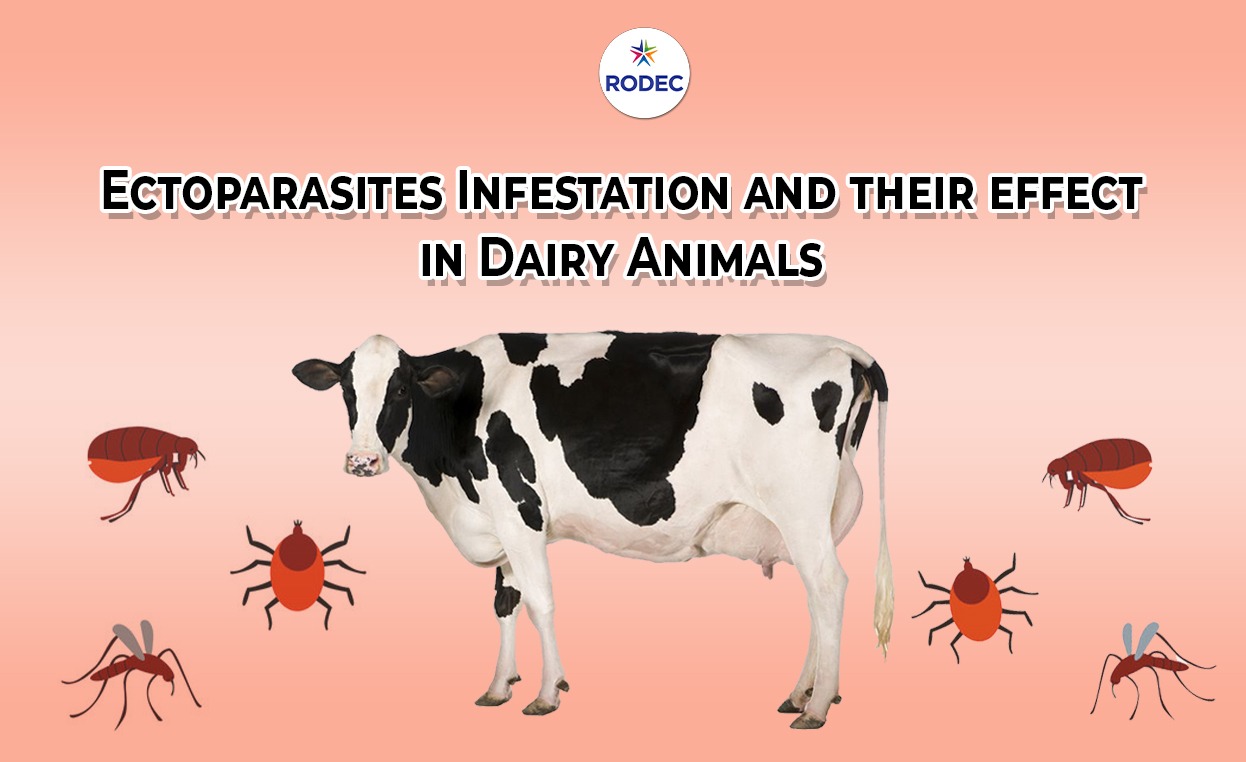
Blog |
July 08, 2024
Summers are here and so are the problems of lice and ticks in animals. Warm temperature, high humidity, and changes in rainfall patterns lead to a significant increase in ectoparasite infestation in dairy animals like cattles and buffalos. Livestock farmers should be extra careful while caring for their animals in summers. Read more to understand the problems caused by ectoparasites and preventive measures.
What are ectoparasites?
Ectoparasites are organisms that live on the skin of another organism (the host). Lice, mites, and ticks are examples of common ectoparasites in dairy cattle.
Problems caused by Ectoparasite Infestation
Ectoparasites can cause many problems in dairy animals. Some of them are
- Mites Infestation: Mites cause mange, which leads to crusted skin, hair loss, and itching. Ringworm, on the other hand, causes circular patches without itchiness. Both conditions affect various parts of the animal's body, causing discomfort and potential damage to skin.
- Lice Infestations: Lice irritates the skin, causing scratching, biting, and rubbing behavior in animals. This irritation can lead to weight loss and poor condition. Both lice and mites can spread from one animal to another, multiplying the infestations.
- Tick Infestations: Ticks are significant parasites that feed on the host's blood, potentially causing paralysis or transmitting diseases. Tick-borne diseases can be fatal to the host and lead to loss of milk and leather. Ticks can survive for months off the host, posing ongoing risks.
- Fleas Infestation: Flea infections can have a severe impact on cattle health. Blood loss during feeding can cause anemia, which causes weakness and lethargy. Bites can induce pruritus (itching) and stress in dairy cattle, resulting in weight loss and consequently reduced milk supply.
Impact of Ectoparasites on Livestock / Dairy Animals:
The impact of ectoparasites on livestock and dairy animals can be huge. Here are some of the ways they can affect animals:
- Reduces milk production: Ectoparasites can cause dairy animals to become restless and irritable, which can lead to decreased feeding time. With less feed consumption, milk production of the animals is reduced.
- Skin damage: Ectoparasites can cause itching and irritation, which can lead to animals scratching and rubbing themselves. This can damage the skin and make animals more susceptible to secondary infections.
- Disease transmission: Some ectoparasites can transmit diseases to livestock and dairy animals like Anaemia (in case of Ticks), Dermatitis (in case of Mange / Lice / Fleas). These diseases can be debilitating and even fatal.
- Increased stress: Ectoparasite infestations can be a major source of stress for animals. This can lead to a number of health problems, including a compromised immune function.
How to Prevent Ecto-Parasitic infestation:
Getting rid of ticks and mites in dairy animals requires a multi-faceted approach that includes both preventive measures and treatment options. Here are some tips dairy farmers can follow:
- Regular grooming: Regular bathing of dairy animals helps in the physical removal of ticks and mites. Check the animal's skin thoroughly for any obvious ticks or mites and remove them with a soft brush. This should be done on a regular basis, particularly in regions where ticks and mites thrive.
- Maintain clean living conditions: Keep the animal sheds clean and dry to prevent ticks and mites from reproducing. Manure and dirty bedding should be removed on a regular basis to prevent pest infestation. Consider putting diatomaceous earth on your mattress to help prevent ticks and mites.
- Implement pasture management: Rotational grazing and pasture mowing can help reduce tick and mite infestations in outdoor areas where animals graze. Avoid overgrazing, since thick grass provides an ideal habitat for ticks.
- Consider biological control: In order to control pest populations, introduce natural tick and mite predators, such as particular predatory mite species or parasitic wasps. Consult agricultural extension services or practitioners for advice on using biological control measures.
- Monitor for signs of infestation: Regularly check dairy animals for signs of tick and mite infection, such as skin discomfort, hair loss, or visible parasites. Early detection allows for rapid treatment, preventing infestations from spreading.
- Consult with a veterinarian: If you suspect a tick or mite infection in your dairy cows, consult a veterinarian. They can offer suitable treatment options, such as topical or systemic drugs, as well as advice on how to manage and avoid frequent infestations.
By combining these measures and adopting a complete pest management strategy, dairy farmers can effectively reduce ticks and mites in their cows while also improving animal health and welfare.
Related Products: ZuSAFA, Tiknash
Written By: Anisha Arora


